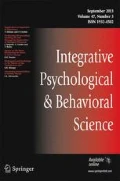Abstract
Neurotic behavior is explained according to the theory of Pavlov as collision between excitation and inhibition. This internal inhibition imposes a burden on the nervous system. The stress can be relieved by what Pavlov called external inhibition, which is actually excitation of another activity. This principle is applied to the human being in explaining the interaction between nervous centers, the advantage of voluntary self-discipline over imposed discipline. Rioting and social unrest is explained in the terms of conflict between excitation and inhibition.
Rights and permissions
About this article
Cite this article
Gantt, W.H. The role of inhibition in neurotic behavior. Conditional Reflex 3, 65–68 (1968). https://doi.org/10.1007/BF03001138
Issue Date:
DOI: https://doi.org/10.1007/BF03001138

